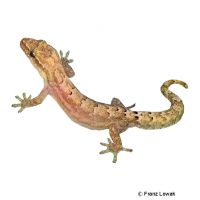Mourning Gecko (Lepidodactylus lugubris)
| Mourning Gecko Lepidodactylus lugubris | |
|---|---|
| Name | Mourning Gecko |
| Name Lat. | Lepidodactylus lugubris |
| Family | Geckos |
| Family lat. | Gekkonidae |
| Order | Scaled Reptiles |
| Order lat. | Squamata |
| Origin | Southeast Asia |
| Habitat | Forests |
| Diet | Insects, fruits |
| Humidity | 50-80 % |
| Behavior | Nocturnal; ♂ territorial |
| Keeping | Pair, group |
| Care Level | Easy |
| Reproduction | Oviparous |
| Housing | Semi-humid terrarium |
| Life Span | 5 years |
| Protection | No |
| Metric Units | |
| Size | 8-10 cm |
| Temperature | 26-28 °C |
| Temperature Local | 35 °C |
| Housing Size | 40 x 40 x 60 cm |
| US Units | |
| Size | 3.1"-3.9" |
| Temperature | 79-82 °F |
| Temperature Local | 95 °F |
| Housing Size | 15" x 15" x 25" |
Distribution and habitat
The crepuscular to nocturnal juvenile geckos originate from Southeast Asia and are now distributed worldwide in tropical and subtropical regions. They occur in different habitats with dense vegetation, but also as cultural successors in settlements.
Maintenance
Minimum dimensions for the terrarium, according to the size and number of animals
| 1-2 animals | 6KRL x 6KRL x 8KRL (L x W x H) |
Head-torso length (KRL) is measured on the largest animal. For each additional animal, increase the footprint by 15%. A terrarium of e.g. 40 x 40 x 60 cm is recommended, which should be placed in a quiet and vibration-free place
You need a terrarium with climbing branches, roots and stone structures as well as many plants, such as Ficus, Scindapsus etc. (hiding and shade places), structured back and side walls (e.g. cork covering), a substrate of forest soil-peat mixture and a water basin. The substrate should always be kept slightly moist. At least once a day the inside of the terrarium should be finely sprayed with water (humidity), but a rain or mist system is better.
| Temp. day: 26-28 °C | Temp. night: 20-24 °C | Temp. local: up to 35 °C | Humidity: 50-80 |
Thermostatically controlled floor heating is recommended. Lighting duration must be 12-14 hrs. Daylight fluorescent tubes are ideal. A special UV light is not necessary.
Diet
The diet consists of live insects, such as crickets, house crickets, grasshoppers, cockroaches, zophobas and mealybug larvae, alternatively special ready-made food for geckos or insectivorous reptiles can be offered, occasionally supplemented with some fruit pulp and sweet fruits (e.g. bananas, papaya). Wax moths should rarely be fed in very small amounts due to their large fat content. Young animals should be offered food daily, adults 4-5 times a week. Regular addition of minerals and vitamins (dusting of feed) is important. Drinking water must always be available, but is preferably taken in drop form from leaves or furnishings
A regular and varied diet promotes health and prevents deficiency symptoms.
Reproduction and breeding
Virgin geckos occur only as females and reproduce parthenogenetically (virgin reproduction).
Eggs are laid every 14-60 days during the summer months. The female sticks her unfertilized, hard-shelled eggs (2 pieces) to the decoration. At an average temperature of 26 °C clones of the mother hatch after 70-90 days. Small insects such as fruit flies and micro crickets are suitable as initial food for the young
The life expectancy can be 5 years.
Important
The females behave territorially within the species. Within a clonal line, the animals differ genetically only slightly
Since they can vary in pattern and coloration depending on mood and background, they can only be distinguished by their size
Sunny places with radiant heat must not be missing.
With fruit and honey water as food for the feeders, their quality can be upgraded.
The terrarium must have good ventilation without drafts and meet the species-specific needs. Measuring devices, such as thermometers, hygrometers, etc. are necessary. The lighting has to correspond to the species-specific day-night rhythm and has to be placed in such a way that the animals cannot injure themselves. The terrarium should be locked in such a way that neither unauthorized persons can open it nor the animals can escape. Contamination must be removed regularly.
Further literature can be found in your pet store.
References
Text: petdata; Image: Franz Lowak
Source: BMELV (1997): Tierschutzgutachten - Mindestanforderungen an die Haltung von Reptilien; RÖLL B. (2006): Zwerggeckos Lygodactylus, Natur und Tier-Verlag
- Gemäß § 21 Abs. 5 Tierschutzgesetz idgF
